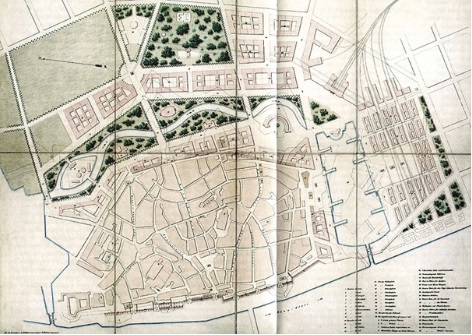„Hin sinkt der Wall, der alte Schutz, es fallen seine Stützen”. Ryska twierdza w XVI–XIX w. i jej defortyfikacja w 1857 r.
Słowa kluczowe:
fortyfikacje, urbanistyka, Litwa, Rosja, XIX w.Abstrakt
The following article presents the issue of the fortification of Riga and associated plans of the suburbs in the 17th and 18th centuries (plans of Johann van Rodenburg and Rudolf Friedrich Härbel), as well as the projects of the transformation of the former fortification zones in the 19th century. Additionally, the paper covers the question of an unknown plan of Riga from 1843. In 1812, as a result of an intentional arson during the Russian campaign, the suburbs were completely destroyed. This prompted Filippo Paulucci to create a new plan that, among others, carefully delineated the transformation of the glacis into a wide esplanade. In 1856, after the Crimean War, a decision was made to de-fortify the city. In November 1857, in a very solemn manner, the process of Riga’s defortification began. Torch -bearing citizens participated in marches across the city, taking part in concerts and collective singing; during all these festivities, the city was brightly illuminated. This event was an amalgamation of solemn state celebrations and a folk, carnival-like fiesta. Celebrations connected with the process of Riga’s defortification belong to a small group of defortifications in European cities celebrated so uproariously.
In early 1857, the architect Johann Daniel Felsko created a remarkably interesting plan developing the former fortification grounds, as well as a new idea of the spatial development of the city. Felsko used the modern division into functional zones: the trading-communication zone (port, depots, railway station, and ‘gostiny dvor’ (‘merchant yard’) and the stately-park zone (palaces, elegant revenue houses, public buildings), which, at that time, was still a great rarity. The conception utilized in Riga definitely overtook the ideas for the Vienna Ring Road (the second half of 1857). In my opinion, Felsko’s idea shares the most similarities with the former fortification zones in Frankfurt am Main, which were reclaimed in 1806. However, his plan was never faithfully realized.
Out of numerous projects concerning the esplanade and promenade on the grounds of the former glacis, in the second half of the 19th century, there emerged one of the most interesting and beautiful European promenade complexes. Some of the first public buildings were the Riga-Daugavpils Railway Station and the theatre; later, school buildings, the Riga Technical University, and numerous palaces and houses were erected there. In the early 20th century, Riga was the third biggest and industrially developed city east of the Oder, reaching the population of over 470,000 citizens in 1913, following Warsaw and Wrocław. Its spatial development ideas, created in the 19th century, were then fully implemented.
Downloads
Bibliografia
Bākule Irēna, Siksna Arnis, Rīga ārpus nocietinājumiem: pilsētas plānota izbūve un pārbuve / Riga beyond the walls The city’s planned growth and transformation from the 17th century to the First World War, Rīga 2009.
Brunstermann Friedrich, Die Geschichte der Kleinen oder St. Johannis-Gilde in Wort und Bild (zum Jubiläumsjahr 1901), Riga 1902.
Campe Paul, Die Stadtore Riga im 17., 18., 19. Jh. und deren Meister [w:] Latvijas Universitates Raksti Acta Universitatis Latviensis Architektura Fakultates Serija II.3, Riga 1939, s. 241–360.
Die Abtragung der Festungswerke Rigas und die damit verbundenen Communalbauten. Bericht und Rechenschaft der ständischen Commission, Riga 1864.
Lāce Daina, Rīgas plānojums 19. gs. vidū: Esošais un vēlamais (Riga planning in the mid19th century: reality and aspirations) [w:] Pilsēta. Laikmets. Vide: Rakstu krājums (= Materiāli Latvijas mākslas vēsturei), ed. Rūta Kaminska, Rīga, 2007.
Lāce Daina, Pirmais Rīgas pilsētas arhitekts Johans Daniels Felsko (1813–1902) / The First Riga City Architect Johann Daniel Felsko (1813–1902), Rīga 2012 (LMA Mākslas vēstures institūts; Rīga: Mākslas vēstures pētījumu atbalsta fonds).
Lāce Daina, City architect of Riga Johann Daniel Felsko 1813–1902, Rīga 2011.
Mintzker Yair, The Defortification of the German City, 1689–1866, Cambridge 2012.
Omilanowska Małgorzata, Defortyfikacja Gdańska na tle przekształceń miast niemieckich w XIX wieku, „Biuletyn Historii Sztuki” 2010, nr 3, s. 293–334.
Omilanowska Małgorzata, Die Entfestigung Danzigs im Kontext der Umgestaltung der deutsche Städte im Laufe des 19. Jahrhunderts [w:] Das maritime Stadt. Hafenstädte an der Ostsee vom Mittelalter bis in die Gegenwart: Beiträge der 21. Tagung des Arbeitskreises deutscher und polnischer Kunsthistoriker und Denkmalpfleger in Gdańsk 18–21 September 2013, Hg. Tomasz Torbus, Katarzyna Anna Wojtczak, Warszawa 2017, (Wspólne dziedzictwo, t.10 / Das Gemeinsame Kulturerbe, Bd. 10) s. 315–360.
Reglement über die Wiederaufbauung der Rigaschen Vorstädte und das Verhältniß der Vorstädte zu den Befestigungen von Riga, Riga 1813.
Wissenbach, Björn, Mauern zu Gärten. 200 Jahre Frankfurter Wallanlagen, Frankfurt am Main 2010.


 Uniwersyteckie Czasopisma Naukowe
Uniwersyteckie Czasopisma Naukowe



